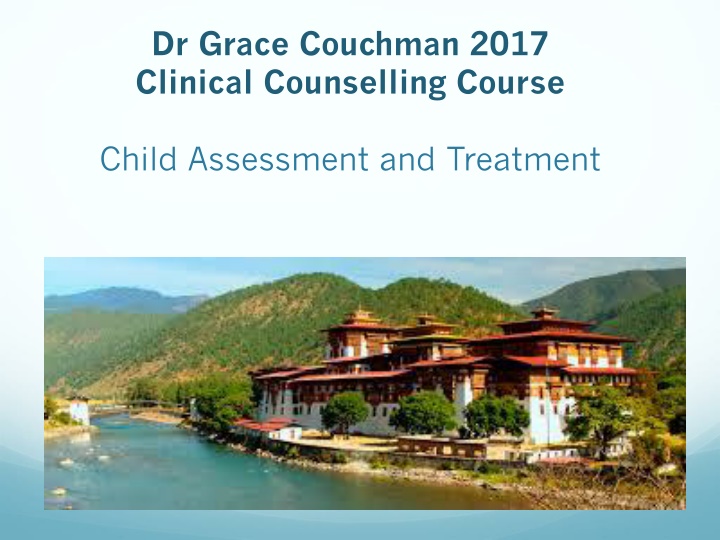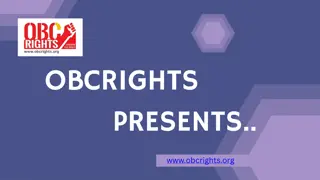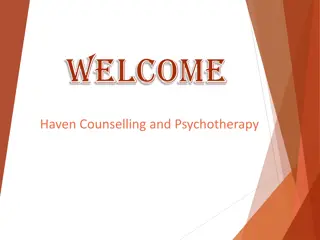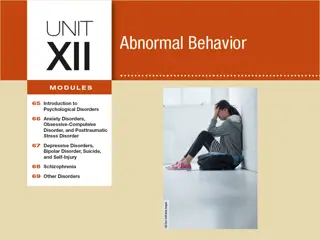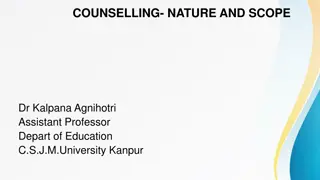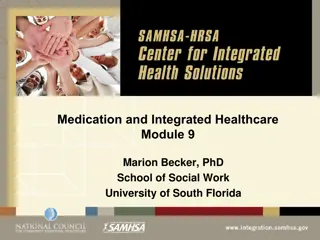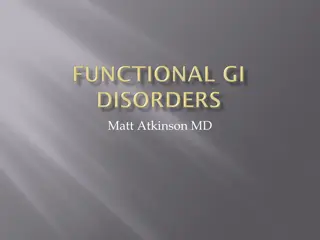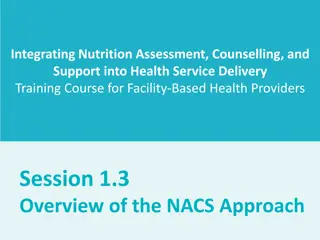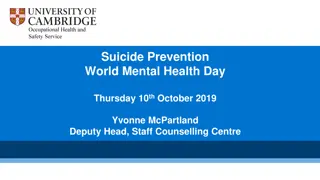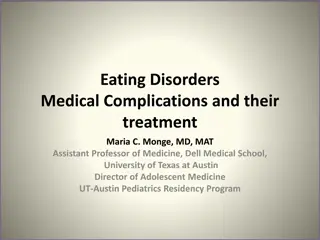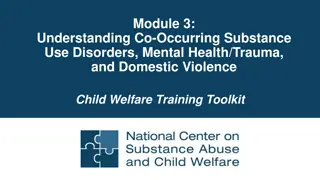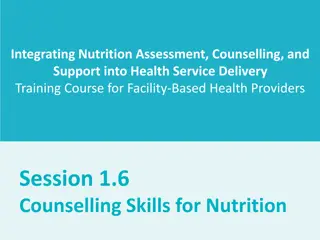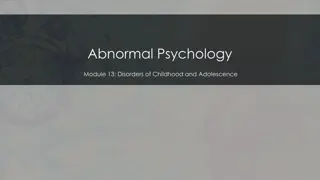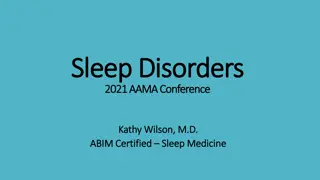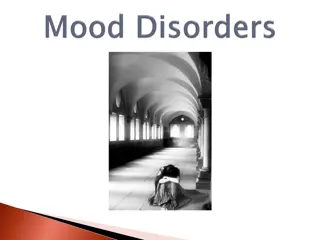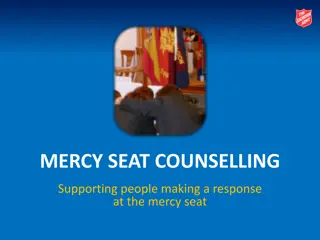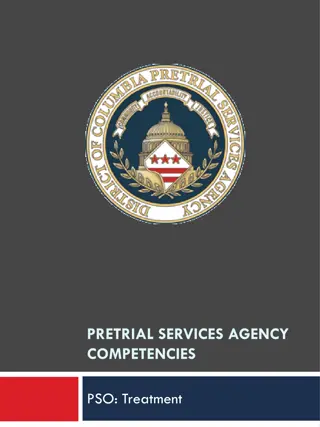Clinical Counselling and Treatment of Child Disorders: Assessment and Interventions
The Clinical Counselling Course by Dr. Grace Couchman in 2017 focuses on child assessment and treatment, covering various disorders such as depression, anxiety, behavior disorders, learning difficulties, autism spectrum disorders, and more. The course emphasizes tools for clinical assessment and counselling with children, addressing neurobiological problems, trauma, family issues, physical health concerns, and emotional causes. Depression in children is explored, highlighting key symptoms, differential diagnosis, and associated risks.
Download Presentation

Please find below an Image/Link to download the presentation.
The content on the website is provided AS IS for your information and personal use only. It may not be sold, licensed, or shared on other websites without obtaining consent from the author.If you encounter any issues during the download, it is possible that the publisher has removed the file from their server.
You are allowed to download the files provided on this website for personal or commercial use, subject to the condition that they are used lawfully. All files are the property of their respective owners.
The content on the website is provided AS IS for your information and personal use only. It may not be sold, licensed, or shared on other websites without obtaining consent from the author.
E N D
Presentation Transcript
Dr Grace Couchman 2017 Clinical Counselling Course Child Assessment and Treatment
Child disorders Depression: reactive or general Anxiety: phobias, social, health, mutism Behaviour disorder: poor social skills, conduct problems, aggression, poor sleeping, eating Toileting: encopresis & enuresis Learning difficulties: global or specific (dyslexia, processing, adhd) Autism Spectrum disorders Psychosis
Tools for clinical assessment of children Child interview Observation of interactions/behaviour Parent interview Drawing Miracle question or 3 wishes Play with toys Teacher or school report Standardised test
Tools for clinical counselling with children Debriefing and encouragement of self expression Cognitive behavioural practice Reward and monitoring of behaviour Parent training Relaxation training Planning for adjusted expectations Creative therapies- role play /drawing
Neurobiological problems: e.g., Intellectual disability, autism, learning difficulties and prodrome Trauma: e.g., divorce, violence, catastrophe Patient-centred problems: e.g., of thinking, interacting and coping Family and parenting: e.g., disorganisation, parental illness, poor parenting skills, socio- economic stress, alcoholism Physical problems: e.g., hearing, sight, epilepsy, bowel function Look for social-emotional causes and then individual psycho-emotional causes before concluding a chronic biological cause
Depression in children 2% of children and 5% of adolescents Mostly the same as adults: Episode lasting more than 2 weeks of pervasive low mood, loss of interest or pleasure, weight changes, physical slowness, worthlessness, fatigue, poor concentration But children are more likely to be cranky & irritable or moody instead of straight sad, with static weight despite growth, poor work at school, withdrawal and not playing and maybe simply thinking of death/dying In teenagers, depression is associated with drugs and alcohol and self harm or suicidal thinking Differential diagnosis: thyroid problems, drug abuse, post viral syndrome, avoidance due to anxiety
Treating depression We need to work slowly: listening, empathising, suggesting, challenging Even if the feelings seem irrational, they seem real to the patient-a deep sense of hopelessness. Encourage the patient to explain the hopelessness/ worthlesssness and even talk about thoughts of death Create a timeline of depression and locate precipitants and also variations in mood and self worth over months/years--highlight the variations. Identify irritability, reactiveness, bursts of aggression and map the context, e.g., where and with whom. Common themes for children- I m stupid, I m bad, I m weak, No one loves me, no one cares, Identify places, people, ideas which seem to make it worse- and activities which create a holiday from depression. Encourage behavioural activation (playing, walking, hobbies, socialising- but start small) Explore social/family narratives which create poor self identity (parents, siblings ++, peers) and provide psychoeducation about how we take on these ideas even when they are wrong. Provide psycheducation to family where possible (positive interaction, boosting, open talk) Explore any secondary gains or defences which favour depression, e.g., fear of asserting one s self, feelings of anger, avoidance of school or activities, or situation, e.g, visiting separated parents Once the child feels you understand (? 2 to 4 sessions), start to positively challenge their ideas about themselves, their skills, their worth and their future (CBT) In children, anti-depressants are largely ineffective.
Treating depression Adolescents In adolescence, CBT is most effective and can be combined with anti-depressants if absolutely necessary. Pay attention to the narratives of the peer group and challenge unhelpful relationships and ideas Be sympathetic but discuss some of the identity confusion, need for independence, & existential worry as growing up . Explore intimate relationships and worries about them Explore drug use including caffeine
14yr old Rinchen : presentation: anxiety /depression 4 yrs of headaches & chest pain & fear Good student, usually active & sincere More recently, moody & loss of interest Alone disclosed- persistent worries fa will die & he will need to care for younger bros History of problem Parent separation 5 yrs ago Mo has relocated to U.S.- weekly contact Tried a relocation to rural area for science program with unhappy aunt Fa continues to cry & remind son that he won t always be here forever Treatment Normalised the distress of recent changes and relocation Encourage a positive view of symptoms Encouraged positive activity away from study Education of father re supportive talk and resolution of his distress (just starting to talk to Mo) Encourage Tenzin opening up to mother in phone calls
Anxiety in children There s a number of prominent anxieties. Anxiety is hard to assess because people are reactive to the anxiety and can t talk about it. 10 to 15% of children have anxiety. Separation anxiety: fear of being alone from the parent or fear of the parents being away. Sometimes see this when a child is scared of coming to harm (fear of death or ?) or is scared for parents safety (e.g., violent/suicidal parents) (school refusal, clinging, tantrums when left in other s care) Health anxiety: fear of being sick, germs, having needles at the hospital. Often needs considerable exploration to work out what is the main fear , e.g., vomiting (hand washing, avoidance of touching things, tantrums when being taken to doctor, checking and asking parents about cleanliness) Social anxiety: acute shyness, terror of talking to family or in public, fears of rejection (acute social withdrawal, school refusal, selective mutism) Obsessive/compulsive disorder- this tends to be more serious and more rigid with ritualistic behaviours (touching doorknobs, washing hands, counting, checking). Panic attack has usually grown out of the issues above but has taken on an acute presentation (chest pain, nausea, heart beating, hyperventilation) Otherwise General anxiety
Treating anxiety Identify the anxiety the hardest job- it takes a few goes because the patient is anxious about the anxiety Psychoeducation about anxiety and how it can make things seem worse than they are (join with the patient against the anxiety) Address basic issues of safety, parent mental illness/home violence, bullies at school (including teachers). It may mean asking for action! Assess for learning difficulties For the arousal; teach basic breathing (3 in : 4 out), relaxation, mindful strategies, distraction techniques, and cognitive techniques ( its okay , its just anxiety talking , I can do this ) For the content (germs, fear of harm, fear of needles) Challenge the rationality of the fear (plant seeds of doubt Use a behavioural chart to monitor and chart success --4 wks by parents or patient Encourage regular de-sensitisation (active exposure to the object/situation) Discourage parents from helping the patient avoid and encourage them to support bravery.
Pema 16- acute anxiety- feeling in a panic and cant study Worries about school and doing well in exams class 11 Not sleeping well Assessment Supportive family Low family pressure Good student with pending exam Using lots of caffeine at night (coke 2 litres) with sleep disturbance and watching korean drama into the early am. No peer problems or alcohol /illegal drug use Treatment Provided with amitriptyline by Dr Reduce coke intake (nothing after 3pm) Develop night-time routine- no study or tech after 10 and relaxing music Watch korean drama in between study sessions early in pm Develop meditation/breathing practice Informed parent
13 yr old: presentation-selective mutism/ social anxiety School refusal Tantrums Not speaking Isolated/insular- plays in room alone (sings hindi songs) Assessment Parental neglect & isolated life Fa alcoholic & violent: swings Mo by her hair Mo stressed & busy ?neglectful Child fearful for mother s safety Attempted pp twice had to walk with other children to school ? specific Learning disability avoidance from school Treatment Highlight of violence- Transfer to safer housing (by family) Positive encouragement and support for child s anxiety Behavioural reward for self-expression Information provided to new school Parents invited to session but refused
Migma 17- fainting (1 to 3 x/day) and acute anxiety 1 month- any times she thinks of study. In class 8. From Wangdue- 1 session only- General Anxiety with Dissociation Assessment Supportive family excited by her education and encouraging. Enjoys family events Fainting mostly at school when thinking of study and failing and being humiliated Average student who repeated pp but wants yr12 Criticism by peers (failure, poor student)- reported to her by her cousin- very distressing Viewed by others as depressed and may be. Treatment Provided with amitriptyline by Dr Psychoed about hyperventilation Practice of meditation/breathing (10 breaths x 5/day) CBT : Highlighted positive attributes. What keeps you working so hard despite fainting ? - determination and I ll show them . Also, challenged letting others judge our character, Also, encouraged self control of her study plan (Plan A AND Plan B) Clear written instructions provided in the health booklet
